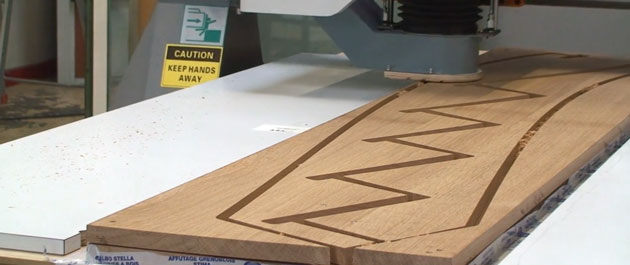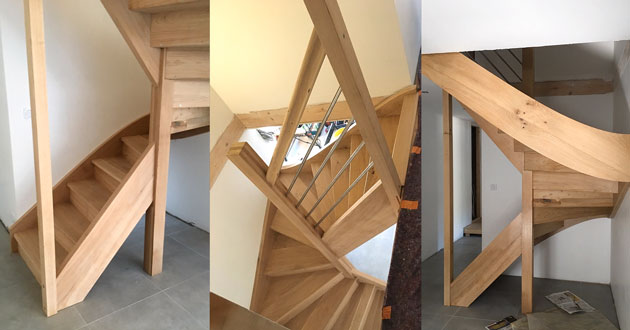In this case study we’re using a 3-axis CNC machine to manufacture a stair that consists of solid wood parts prepared from raw timber.
This is one of the CNCs we offer and is typically used for nested manufacture of cabinetry and other furniture using sheet materials.
CNC stair production can be done on a pod and rail machine, but these are A LOT more expensive, and there are other issues we discuss later on too.
In particular we think this solution is great for small to medium workshops.
The project we show is a half turn winding stair in solid oak.
The stair was designed in StairDesigner then exported to the VCarve Pro CAM software which generates the machine files to actually run the CNC.
We’ve made a short video of the CNC production, please take a look below:
Winders
First up in the video, 2 sets of winders are cut, along with the grooves for the risers. To minimise waste the boards have been prepared to cut the winders in pairs.
This CNC has a 10 tool automatic tool changer (ATC) which you can see in action right at the start picking up a 12 mm carbide bit. In fact, this bit was used throughout the video.

The milling bit cuts out the winders over several runs, leaving a shallow depth final cut of 0.5 mm.
This keeps the maximum vacuum hold down until the final cut and minimises the lateral effort on the parts as they are detached.
Please note as well how little dust is left on the parts and machine, there are only a few chippings released.
We’ve spent a lot of time and effort perfecting our dust collection system, we’re really happy with the results we’ve achieved.
Stringboards
The string boards are now cut. They are 50 mm thick and include 15 mm deep housing for the steps and risers.

You can also see melamine boards placed around the parts, which concentrates the vacuum hold down underneath the parts we’re cutting out.
Ness Tillson, one of the company directors here at Wood Designer, spent many years making stairs. The box strings are manufactured here using a 3 part technique Ness developed himself. It is an effective way to allow a stair to be assembled on site between 2 walls.
We have more details on this technique here:
How to Build a Staircase Between 2 Walls
Stair with 3 Part String between Plaster Board Walls
Newel posts
The video shows the lower newel post, specifically cutting out the step and riser housings, again with the 12 mm drill bit.

The post is flipped onto each side to be done separately, with a machine file for each face, face 1, 2, 3 in this case.
You can also see an aluminium rail used as a stop for the “0” Y reference of the newel post. The same for the white board on the left which is used to position the post’s “0” X reference.
Once positioned like this, you can set the zero point on the machine to the bottom left of the part.
The finished stair
Finally, in these pictures you can see the finished stair, complete with stainless steel railings.

Benefits of CNC stair manufacture
Let’s first compare this method with non CNC production where you would be marking out by hand, cutting parts with a saw, using a hand router for the housing and cutting to shape and finishing the stingers.
CNC production is practically automatic and clearly much faster, but it is also 100% precise.
Everything fits together perfectly, and there’s no need to adjust parts later on. So errors and material waste are minimised too.
And remember we’ve designed the stair in StairDesigner which in itself is parametric software and made to calculate your stair accurately and very fast.
There’s no marking out of steps to cut to shape. And there’s a massive reduction in the time taken to cut the housings and shape of the stringers.
3-axis versus pod and rail CNCs
Pod and rail CNCs are very different to the 3-axis machine used for this project. They are 4 or 5 axis machines where you place a single part one at a time on the CNC.
Pod and rail machines hold the part firmly, but as you can see a nesting 3-axis machine offers great hold down too. In particular, we have engineered the hold down on our machines to achieve much better results than comparable machines on the market today.
The one key benefit though of a 4/5-axis pod and rail CNC is that you can drill at an angle. So in this project, the angled holes for the steel railings were manufactured separately. This would have been possible on a 4 or 5 axis pod and rail.
On the other hand, pod and rail CNCs are much more expensive. They are also much more complicated, more can go wrong and cost more to fix.
If you are doing many stairs each month, it pays to automate every last part of your workflow. However, for smaller workshops doing 5-10 stairs or less a month, we believe the 3-axis solution is much better value for money.
You can automate almost all stair production for a much lower financial outlay. If you build custom cabinets and furniture as well, you’ve also got the perfect CNC for that.
Details including prices for our woodwork CNC solutions can be found here.
Please contact us if you would like to come to the showroom to see these CNCs in action.

Hi,
I’m thinking already for quite some time to start a small workshop in which to be able to build custom wood staircases, as well as perhaps other wood cabinetry, taking advantage of StairDesigner software. The main showstopper so far was the prohibitive costs of CNC machines hence I became quite interested by the alternative you are proposing.
I would be interested on the actual prices and manufacturing possibilities of such lower costs machines. As cuting seems to be done without problems, I’m wondering if other milling operations are possible (some stairs are not simple pieces of wood but clients are requiring different models on them)
Looking forward to hearing from you.
Best regards,
Daniel
Hi Daniel, thanks for your comment. Certainly a 3 axis machine cannot do some angled drilling and cuts for example, but you will be able to manufacture almost the entire stair in this way. That’s why we think it’s a good affordable solution for lots of businesses. Plus, compared with a 4/5-axis machine, you’ll get a relatively simple CNC that is less likely to go wrong and parts also cost A LOT less. I’ll email you some details now. Thanks